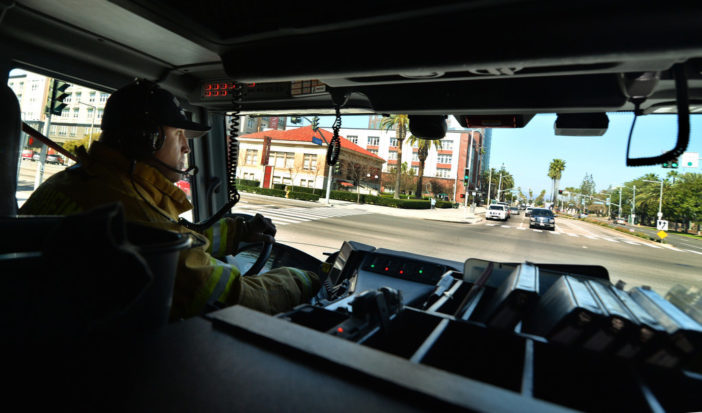Seconds count.
And in the fire service, a few seconds can mean the difference between life and death.
That’s why Anaheim Fire & Rescue has been rolling out technology to help its trucks and engines get through intersections quicker without compromising safety.
The agency’s Emergency Vehicle Preemption (EVP) system, launched in 2014 and expanded last year, is poised to grow even more, with more intersections being equipped with global positioning system (GPS) technology that triggers green lights when AF&R crews approach.
Intersections in Anaheim now equipped with the GPS-based technology total 65, up from 27 in August 2014, Deputy Chief Jeff Alario said.
Chief Alario said AF&R will be asking the City Council this year to allocate an additional $200,000 to cover between 25 and 30 more intersections. The cost to date so far has been $500,000, Alario said.
“There are a lot of advantages to this system, and our goal would be to someday have all city intersections equipped with it,” Alario said.
“In any medical aid or fire call, seconds count.”
Emergency vehicles must come to a complete stop at red lights before passing through. It takes time for the heavy apparatus to regain speed, adding more seconds to response time.
Back in the day, fire departments used strobe lights to trigger a change in traffic signals. But they had to be replaced often and required high maintenance and no longer are in use.

Anaheim Fire & Rescue Deputy Chief Jeff Alario: “There are a lot of advantages to this system, and our goal would be to someday have all city intersections equipped with it.”
Photo by Steven Georges/Behind the Badge OC
Agencies since then have turned to infrared-based systems, but such systems have a drawback: a truck or engine has to be in the line of sight of an intersection for the traffic signal system to work.
AF&R uses a GPS emitter that works even without a line of sight to the intersection because the GPS signal is bounced off a satellite. The technology also can work with existing infrared-based systems if the engine or truck responds to calls in another city.
AF&R’s Opticom system, manufactured by Global Traffic Technologies, is housed in a small black box on the top of the apparatus. These GPS emitters are automatically activated when AF&R rolls to Code 3 calls — lights and sirens on.
And they automatically are deactivated when the engineer applies the parking brake in an engine or truck, indicating that the apparatus has arrived at the scene of an emergency.
Global Traffic Technologies, in a video it produced, says its Opticom system can improve response rates up to 25 percent and reduce crash rates by 70 percent.
All of AF&R’s trucks and engines, with the exception of apparatus designed to fight fires in the wilderness, have been equipped with the GPS emitters, sold through Chino-based vendor DDL Traffic Inc.
Now AF&R, working with the city’s Traffic Department, is hoping to get GPS receivers installed at more intersections.
Alario said AF&R has established corridors of intersections that are equipped with the technology. For example, the system is in place along long stretches of Lincoln Avenue, Anaheim Boulevard, State College Boulevard and Euclid Street.
One key feature of AF&R’s Emergency Vehicle Preemption system is that it accounts for pedestrians who may be going through a crosswalk when the system is activated. The system has a built-in delay of up to 28 seconds, giving people time to safely go through crosswalks before the emergency vehicle arrives.
“What we didn’t want to do is shorten the time frame that a pedestrian has to get through a crosswalk,” Alario said.
The system also accounts for vehicles, say, waiting to make a left turn at a green light. Such traffic is moved through the intersection before the emergency vehicle arrives.
 Behind the Badge
Behind the Badge



